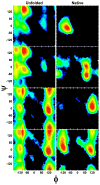Context and force field dependence of the loss of protein backbone entropy upon folding using realistic denatured and native state ensembles
- PMID: 22928488
- PMCID: PMC3464005
- DOI: 10.1021/ja3064028
Context and force field dependence of the loss of protein backbone entropy upon folding using realistic denatured and native state ensembles
Abstract
The loss of conformational entropy is the largest unfavorable quantity affecting a protein's stability. We calculate the reduction in the number of backbone conformations upon folding using the distribution of backbone dihedral angles (ϕ,ψ) obtained from an experimentally validated denatured state model, along with all-atom simulations for both the denatured and native states. The average loss of entropy per residue is TΔS(BB)(U-N) = 0.7, 0.9, or 1.1 kcal·mol(-1) at T = 298 K, depending on the force field used, with a 0.6 kcal·mol(-1) dispersion across the sequence. The average equates to a decrease of a factor of 3-7 in the number of conformations available per residue (f = Ω(Denatured)/Ω(Native)) or to a total of f(tot) = 3(n)-7(n) for an n residue protein. Our value is smaller than most previous estimates where f = 7-20, that is, our computed TΔS(BB)(U-N) is smaller by 10-100 kcal mol(-1) for n = 100. The differences emerge from our use of realistic native and denatured state ensembles as well as from the inclusion of accurate local sequence preferences, neighbor effects, and correlated motions (vibrations), in contrast to some previous studies that invoke gross assumptions about the entropy in either or both states. We find that the loss of entropy primarily depends on the local environment and less on properties of the native state, with the exception of α-helical residues in some force fields.
Conflict of interest statement
The authors declare no competing financial interest.
Figures




Similar articles
-
Loss of conformational entropy in protein folding calculated using realistic ensembles and its implications for NMR-based calculations.Proc Natl Acad Sci U S A. 2014 Oct 28;111(43):15396-401. doi: 10.1073/pnas.1407768111. Epub 2014 Oct 13. Proc Natl Acad Sci U S A. 2014. PMID: 25313044 Free PMC article.
-
Empirical evaluation of the influence of side chains on the conformational entropy of the polypeptide backbone.Proteins. 1995 Jun;22(2):132-40. doi: 10.1002/prot.340220206. Proteins. 1995. PMID: 7567961
-
The nature of the free energy barriers to two-state folding.Proteins. 2004 Oct 1;57(1):142-52. doi: 10.1002/prot.20172. Proteins. 2004. PMID: 15326600
-
Thermodynamics of protein denatured states.Mol Biosyst. 2007 Feb;3(2):88-99. doi: 10.1039/b611895j. Epub 2006 Nov 7. Mol Biosyst. 2007. PMID: 17245488 Review.
-
The osmophobic effect: natural selection of a thermodynamic force in protein folding.J Mol Biol. 2001 Jul 27;310(5):955-63. doi: 10.1006/jmbi.2001.4819. J Mol Biol. 2001. PMID: 11502004 Review.
Cited by
-
Glycine in Water Favors the Polyproline II State.Biomolecules. 2020 Jul 29;10(8):1121. doi: 10.3390/biom10081121. Biomolecules. 2020. PMID: 32751224 Free PMC article.
-
On the relationship between NMR-derived amide order parameters and protein backbone entropy changes.Proteins. 2015 May;83(5):922-30. doi: 10.1002/prot.24789. Epub 2015 Mar 25. Proteins. 2015. PMID: 25739366 Free PMC article.
-
Loss of conformational entropy in protein folding calculated using realistic ensembles and its implications for NMR-based calculations.Proc Natl Acad Sci U S A. 2014 Oct 28;111(43):15396-401. doi: 10.1073/pnas.1407768111. Epub 2014 Oct 13. Proc Natl Acad Sci U S A. 2014. PMID: 25313044 Free PMC article.
-
Local order in the unfolded state: conformational biases and nearest neighbor interactions.Biomolecules. 2014 Jul 24;4(3):725-73. doi: 10.3390/biom4030725. Biomolecules. 2014. PMID: 25062017 Free PMC article. Review.
-
Randomizing of Oligopeptide Conformations by Nearest Neighbor Interactions between Amino Acid Residues.Biomolecules. 2022 May 11;12(5):684. doi: 10.3390/biom12050684. Biomolecules. 2022. PMID: 35625612 Free PMC article.
References
-
- Stites WE, Pranata J. Proteins. 1995;22:132–40. - PubMed
-
- Meirovitch H. Curr Opin Struct Biol. 2007;17:181–6. - PubMed
-
- D’Aquino JA, Gomez J, Hilser VJ, Lee KH, Amzel LM, Freire E. Proteins. 1996;25:143–56. - PubMed
-
- Yang D, Kay LE. J Mol Biol. 1996;263:369–82. - PubMed
-
- Zaman MH, Shen MY, Berry RS, Freed KF, Sosnick TR. J Mol Biol. 2003;331:693–711. - PubMed
Publication types
MeSH terms
Substances
Grants and funding
LinkOut - more resources
Full Text Sources

